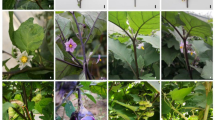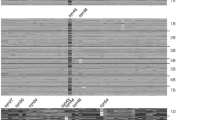Abstract
Key message
This study provides a link between a de novo gene and novel phenotype in wheat–rye hybrids that can be used as a model for induced de novo genetic variation.
Abstract
Wide hybridization can produce de novo DNA variation that may cause novel phenotypes. However, there is still a lack of specific links between changed genes and novel phenotypes in wide hybrids. The well-studied high-molecular-weight glutenin subunit (HMW-GS) genes in tribe Triticeae provide a useful model for addressing this issue. In this study, we investigated the feasibility of a wheat–rye hybridization method for inducing de novo phenotypes using the Glu-1Dx2.2 subunit as an example. We developed three hexaploid wheat lines with normal fertility and a Glu-1Dx2.2 variant, named Glu-1Dx2.2 v, derived from three F1 hybrids. The wild-type Glu-1Dx2.2 has two direct repeats of 295 bp length separated by an intervening 101 bp in its central repetitive region. In the mutant Glu-1Dx2.2 v, one copy of the repeats and the intervening sequence were deleted, probably through homology-dependent illegitimate recombination (IR). This study provides a direct link between a de novo allele and novel phenotype. Our results indicate that the wheat–rye method may be a useful tool to induce de novo genetic variations that broaden the genetic diversity for wheat improvement.





Similar content being viewed by others
References
Arnold MA (1997) Natural hybridization and evolution. Oxford University Press, New York
Bennetzen JL (2002) Mechanisms and rates of genome expansion and contraction in flowering plants. Genetica 115:29–36
Bennetzen JL (2007) Patterns in grass genome evolution. Curr Opin Plant Biol 10:176–181
Chantret N, Salse J, Sabot F, Rahman S, Bellec A, Laubin B, Dubois I, Dossat C, Sourdille P, Joudrier P (2005) Molecular basis of evolutionary events that shaped the hardness locus in diploid and polyploid wheat species (Triticum and Aegilops). Plant Cell 17:1033–1045
Chen ZJ (2007) Genetic and epigenetic mechanisms for gene expression and phenotypic variation in plant polyploids. Ann Rev Plant Biol 58:377–406
Contento A, Heslop-Harrison J, Schwarzacher T (2005) Diversity of a major repetitive DNA sequence in diploid and polyploid Triticeae. Cytogenet Genome Res 109:34–42
Crouch J, Payne T, Dreisigacker S, Wu H, Braun H (2009) Improved discovery and utilization of new traits for breeding. In: Dixon J, Braum HJ, Kosina P, Crouch J (eds) Wheat facts and futures 2009. CIMMYT, Mexico, pp 42–51
Devos KM, Brown JK, Bennetzen JL (2002) Genome size reduction through illegitimate recombination counteracts genome expansion in Arabidopsis. Genome Res 12:1075–1079
Dvorak J, Akhunov ED, Akhunov AR, Deal KR, Luo MC (2006) Molecular characterization of a diagnostic DNA marker for domesticated tetraploid wheat provides evidence for gene flow from wild tetraploid wheat to hexaploid wheat. Mol Biol Evol 23:1386–1396
Feldman M (2001) Origin of cultivated wheat. In: Bonjean AP, Angus WJ (eds) The world wheat book, a history of wheat breeding. Lavoisier Publishing, Paris, pp 3–56
Feldman M, Levy AA (2009) Genome evolution in allopolyploid wheat—a revolutionary reprogramming followed by gradual changes. J Genet Genomics 36:511–518
Finigan P, Tanurdzic M, Martienssen RA (2012) Origins of novel phenotypic variation in polyploids. In: Soltis PS, Soltis DE (eds) Polyploidy and genome evolution. Springer, Berlin, pp 57–76
Fujisawa M, Yamagata H, Kamiya K, Nakamura M, Saji S, Kanamori H, Wu J, Matsumoto T, Sasaki T (2006) Sequence comparison of distal and proximal ribosomal DNA arrays in rice (Oryza sativa L.) chromosome 9S and analysis of their flanking regions. Theor Appl Genet 113:419–428
Gao X, Liu SW, Sun Q, Xia GM (2010) High frequency of HMW-GS sequence variation through somatic hybridization between Agropyron elongatum and common wheat. Planta 231:245–250
Gupta PK, Priyadarshan PM (1982) Triticale, present status and future prospects. Adv Genet 21:255–345
Han F, Liu B, Fedak G, Liu Z (2004) Genomic constitution and variation in five partial amphiploids of wheat—Thinopyrum intermedium as revealed by GISH, multicolor GISH and seed storage protein analysis. Theor Appl Genet 109:1070–1076
Hao M, Luo J, Yang M, Zhang L, Yan Z, Yuan Z, Zheng Y, Zhang H, Liu D, Gustafson P (2011) Comparison of homoeologous chromosome pairing between hybrids of wheat genotypes Chinese Spring ph1b and Kaixian-luohanmai with rye. Genome 54:959–964
Hao M, Luo J, Zhang L, Yuan Z, Yang Y, Wu M, Chen W, Zheng Y, Zhang H, Liu D (2013) Production of hexaploid triticale by a synthetic hexaploid wheat–rye hybrid method. Euphytica 193:347–357
Hawkesford MJ, Araus JL, Park R, Calderini D, Miralles D, Shen T, Zhang J, Parry MA (2013) Prospects of doubling global wheat yields. Food Energy Secur 2:34–48
Hu X, Dai S, Pu Z, Liu D, Pu Z, Jiang J, Wei Y, Wu B, Lan X, Zheng Y, Yan Z (2013) Quality of synthetic hexaploid wheat containing null alleles at Glu-A1 and Glu-B1 loci. J Genet 92:241–245
Jiang QT, Zhao QZ, Yang Q, Ma J, Zhang XW, Wang CS, Wang XY, Cao X, Lu ZX, Wei YM (2014) Amphidiploids between tetraploid wheat and Aegilops sharonensis Eig exhibit variations in high-molecular-weight glutenin subunits. Genet Resour Crop Evol 61:299–305
Kihara H (1944) Discovery of the DD-analyser, one of the ancestors of Triticum vulgare. Agric Hortic 19:13–14
Ko JM, Park HM, Cho JH, Suh DY (2004) Alteration of HMW glutenin subunits in wheat lines possessing new 1BL. 1RS translocation. Gene Genomics 26:261–267
Kong XY, Gu YQ, You FM, Dubcovsky J, Anderson OD (2004) Dynamics of the evolution of orthologous and paralogous portions of a complex locus region in two genomes of allopolyploid wheat. Plant Mol Biol 54:55–69
Liu B, Wendel JF (2002) Non-mendelian phenomena in allopolyploid genome evolution. Curr Genomics 3:489–505
Liu B, Vega J, Feldman M (1998) Rapid genomic changes in newly synthesized amphiploids of Triticum and Aegilops. II. Changes in low-copy coding DNA sequences. Genome 41:535–542
Liu D, Zhang H, Zhang L, Yuan Z, Hao M, Zheng Y (2014) Distant hybridization: a tool for interspecific manipulation of chromosomes. In: Kumar J, Pratap A (eds) Alien gene transfer in crop plants. Springer, New York, pp 25–42
Luo J, Hao M, Zhang L, Chen J, Zhang L, Yuan Z, Yan Z, Zheng Y, Zhang H, Yen Y (2012) Microsatellite mutation rate during allohexaploidization of newly resynthesized wheat. Int J Mol Sci 13:12533–12543
Ma XF, Gustafson JP (2008) Allopolyploidization-accommodated genomic sequence changes in triticale. Ann Bot 101:825–832
McClintock B (1984) The significance of responses of the genome to challenge. Science 226:792–801
McFadden E, Sears E (1946) The origin of Triticum spelta and its free-threshing hexaploid relatives. J Hered 37:107–116
Mestiri I, Chagué V, Tanguy AM, Huneau C, Huteau V, Belcram H, Coriton O, Chalhoub B, Jahier J (2010) Newly synthesized wheat allohexaploids display progenitor—dependent meiotic stability and aneuploidy but structural genomic additivity. New Phytol 186:86–101
Nakamura H (2001) Genetic diversity of high-molecular-weight glutenin subunit compositions in landraces of hexaploid wheat from Japan. Euphytica 120:227–234
Nakamura H, Fujimaki H (2002) Specific Glu-D1 f allele frequency of Japanese common wheat compared with distribution of Glu-1 alleles in chinese wheat. Cereal Chem 79:486–490
Ozkan H, Levy AA, Feldman M (2001) Allopolyploidy-induced rapid genome evolution in the wheat (Aegilops–Triticum) group. Plant Cell 13:1735–1747
Payne PI (1987) Genetics of wheat storage proteins and the effect of allelic variation on bread-making quality. Ann Rev Plant Physiol 38:141–153
Qi L, Friebe B, Zhang P, Gill BS (2007) Homoeologous recombination, chromosome engineering and crop improvement. Chromosome Res 15:3–19
Ramanna MS, Jacobsen E (2003) Relevance of sexual polyploidization for crop improvement—A review. Euphytica 133:3–8
Renny-Byfield S, Kovařík A, Chester M, Nichols RA, Macas J, Novák P, Leitch AR (2012) Independent, rapid and targeted loss of highly repetitive DNA in natural and synthetic allopolyploids of Nicotiana tabacum. PLoS One 7:e36963
Reynolds M, Foulkes MJ, Slafer GA, Berry P, Parry MA, Snape JW, Angus WJ (2009) Raising yield potential in wheat. J Exp Bot 60:1899–1918
Schwarzacher T, Bento M, Gustafson JP, Viegas W, Silva M (2011) Size matters in Triticeae polyploids: larger genomes have higher remodeling. Genome 54:175–183
Sears ER, Miller TE (1985) The history of Chinese spring wheat. Cereal Res Commun 13:261–263
Shaked H, Kashkush K, Ozkan H, Feldman M, Levy AA (2001) Sequence elimination and cytosine methylation are rapid and reproducible responses of the genome to wide hybridization and allopolyploidy in wheat. Plant Cell 13:1749–1759
Shewry P, Halford N, Tatham A (1992) High molecular weight subunits of wheat glutenin. J Cereal Sci 15:105–120
Shewry PR, Tatham AS, Barro F, Barcelo P, Lazzeri P (1995) Biotechnology of breadmaking: unraveling and manipulating the multi-protein gluten complex. Nat Biotechnol 13:1185–1190
Silkova OG, Shchapova AI, Shumny VK (2011) Patterns of meiosis in ABDR amphihaploids depend on the specific type of univalent chromosome division. Euphytica 178:415–426
Stebbins GL (1971) Chromosomal evolution in higher plants. Addison-Wesley, Reading
Tang Z, Fu S, Ren Z, Zou Y (2009) Rapid evolution of simple sequence repeat induced by allopolyploidization. J Mol Evol 69:217–228
Verbruggen I, Veraverbeke W, Vandamme A, Delcour J (1998) Simultaneous isolation of wheat high molecular weight and low molecular weight glutenin subunits. J Cereal Sci 28:25–32
Wan Y, Liu K, Wang D, Shewry P (2000) High-molecular-weight glutenin subunits in the Cylindropyrum and Vertebrata section of the Aegilops genus and identification of subunits related to those encoded by the Dx alleles of common wheat. Theor Appl Genet 101:879–884
Wan Y, Yan Z, Liu K, Zheng Y, D’Ovidio R, Shewry PR, Halford NG, Wang D (2005) Comparative analysis of the D genome-encoded high-molecular weight subunits of glutenin. Theor Appl Genet 111:1183–1190
Wang D (2009) Wide hybridization: engineering the next leap in wheat yield. J Genet Genomics 36:509–510
Wegel E, Vallejos RH, Christou P, Stöger E, Shaw P (2005) Large-scale chromatin decondensation induced in a developmentally activated transgene locus. J Cell Sci 118:1021–1031
Wei YM, Zheng YL, Liu DC, Zhou YH, Lan XJ (2000) Gliadin and HMW-glutenin variations in Triticum turgidum L. ssp.turgidum and T. aestivum L. landraces native to Sichuan, China. Wheat Inform Serv 90:13–20
Wicker T, Yahiaoui N, Guyot R, Schlagenhauf E, Liu ZD, Dubcovsky J, Keller B (2003) Rapid genome divergence at orthologous low molecular weight glutenin loci of the A and Am genomes of wheat. Plant Cell 15:1186–1197
Wicker T, Yahiaoui N, Keller B (2007) Illegitimate recombination is a major evolutionary mechanism for initiating size variation in plant resistance genes. Plant J 51:631–641
Xie R, Wan Y, Zhang Y, Wang D (2001) HMW glutenin subunits in multiploid Aegilops species: composition analysis and molecular cloning of coding sequences. Chin Sci Bull 46:309–313
Yan Z, Wan Y, Liu K, Zheng Y, Wang D (2002) Identification of a novel HMW glutenin subunit and comparison of its amino acid sequence with those of homologous subunits. Chin Sci Bull 47:222–226
Yuan Z, Liu D, Zhang L, Zhang L, Chen W, Yan Z, Zheng Y, Zhang H, Yen Y (2011) Mitotic illegitimate recombination is a mechanism for novel changes in high-molecular-weight glutenin subunits in wheat–rye hybrids. PLoS One 6:e23511
Zhang LQ, Yen Y, Zheng YL, Liu DC (2007) Meiotic restriction in emmer wheat is controlled by one or more nuclear genes that continue to function in derived lines. Sex Plant Reprod 20:159–166
Zhang L, Luo JT, Hao M, Zhang LQ, Yuan ZW, Yan ZH, Liu YX, Zhang B, Liu BL, Liu DC (2012) Genetic map of Triticum turgidum based on a hexaploid wheat population without genetic recombination for D genome. BMC Genet 13:69
Acknowledgments
We thank the two anonymous reviewers for helpful suggestions. This work was supported by projects of the National Natural Science Foundation of China (31201210, 31271723) and the Scientific Research Foundation of the Education Department of Sichuan Province (11ZB056).
Conflict of interest
All authors read the manuscript and do not have any conflict of interest.
Ethical standard
The experiments reported here comply with the current laws of the countries in which they were performed.
Author information
Authors and Affiliations
Corresponding author
Additional information
Communicated by Bernd Friebe.
Z. Yuan, M. Liu and Y. Ouyang have contributed equally to this work.
Rights and permissions
About this article
Cite this article
Yuan, Z., Liu, M., Ouyang, Y. et al. The detection of a de novo allele of the Glu-1Dx gene in wheat–rye hybrid offspring. Theor Appl Genet 127, 2173–2182 (2014). https://doi.org/10.1007/s00122-014-2370-3
Received:
Accepted:
Published:
Issue Date:
DOI: https://doi.org/10.1007/s00122-014-2370-3




